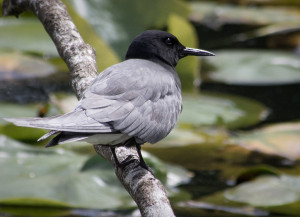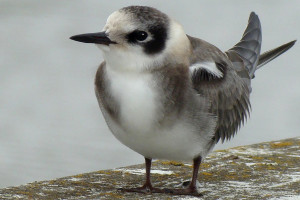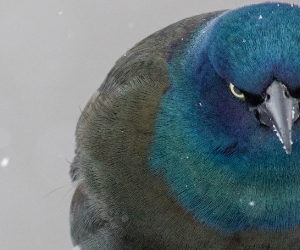Species Spotlight: Black Tern
Get to know some of the species at risk in the Lac Deschênes IBA with the Species Spotlight, aka “Sp-Spot”. Today meet the: Black tern

Black Tern in breeding season
Photo by Ingrid Taylar
Scientific Name: Chlidonias niger
SARA Status: Not listed; Ontario: Special Concern
Taxonomic group: Birds
Size: 20 to 26 cm long, with a wingspan of 57-60 cm. Weight of 50-60 g.
The Black Tern is a small, dark and fresh water bird. It has a forked tail, straight pointed black bill, slender shape and long, narrow wings. During breeding season, the head is black and chest and wings are grey. In non breeding season, the head and underside are white, wings are grey, and there is a dark spot behind eye and dusky crown and nape.
Black Terns like to nest in shallow wetlands like marshes surrounded by emergent vegetation, where they build weak and floating nests, which can be easily destroyed from changing water levels. To overcome these difficulties, black terns can re-nest until late July if an attempt at nesting is unsuccessful. Another adaptation is that Black Tern eggs have a special eggshell which is suited to wet conditions.
Black Terns like to eat mainly insects but also like fish. They catch their prey when they are flying close to water surface.
In Ontario, the Black Tern populations have been reduced or destroyed in many places; the cause is more likely to be the loss of wetland habitat for breeding and migration routes. Some of these habitats are also threatened by invasive plant species which are replacing native vegetation, mainly in coastal and inland wetlands in the Great Lakes basin. Another threat is the reduction of food supply due to the use of pesticides in agriculture and over fishing in the marine winter range.
To maintain and improve the viability of Ontario’s Black Tern population the Ontario government has developed a Plan Management for this species in the province.

Black Tern in non-breeding season
Photo by Maggie Smith
Where Else Can You See This Species?
The Black Tern can be found on inland marshes across Canada, Northwest Territories, British Columbia, Alberta, Saskatchewan, Manitoba, Ontario, Quebec, New Brunswick and Nova Scotia.
In Ontario, the Black Tern is found across the province, north to Big Trout Lake and Fort Albany, along the lower Great Lakes coastlines, Bruce Peninsula, Manitoulin Island, the southern edge of the Canadian Shield. Also, small concentrations are found in the Clay Belt, Lake-of-the-Woods and wetlands adjacent to southern James Bay.
Locally, there have been several observations of Black Terns at the Gatineau- Rapides Deschenes area.
The Black Tern migrates long distances and returns to Ontario in early May to breed. It usually departs by early September.
Did you know?
• The Black Tern is a very social species. In the breeding season it forms semi-colonies, but when it forages, roosts and migrates, they do it in large flocks of a few to more than 100 birds, occasionally up to tens of thousands.
• Their eggs have porous shells to be able to live on their wet environment.
• Black terns, male and female, protect the areas immediately around the nest sites, within two meters.
Check back every week to read about a different species at risk that can be found in Lac Deschênes.
You can report sightings of this and other rare species to the Canadian Wildlife Service at (819) 997-2800 or on the MNR Natural Heritage Information Centre website. A photo and a location are very helpful!
We would like to thank our guest blogger Monica Reyes for this post. Monica is a conservation volunteer for Nature Canada. She is a biologist from Mexico interested in wildlife conservation and environmental education.




